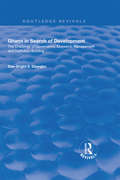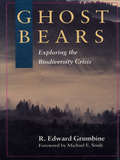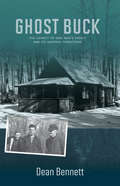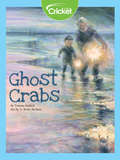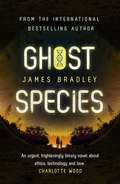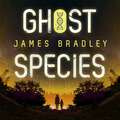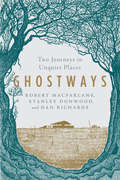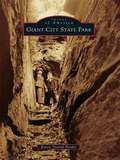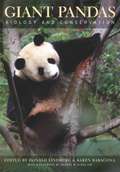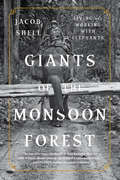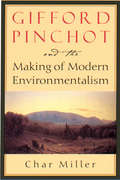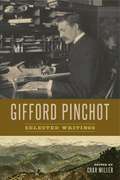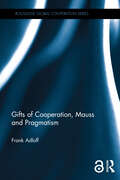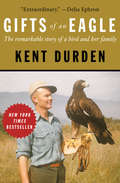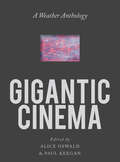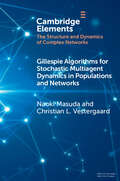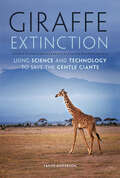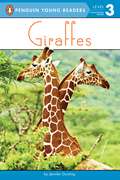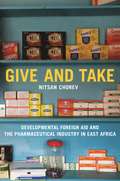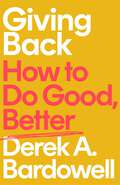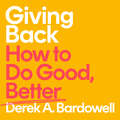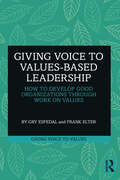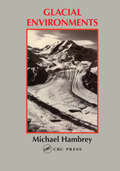- Table View
- List View
Ghana in Search of Development: The Challenge of Governance, Economic Management and Institution Building (Routledge Revivals)
by Dan-Bright S. DzorgboThis title was first published in 2001. When Ghana became independent in 1957, becoming the first country in Sub-Saharan Africa to banish colonialism, there was a general optimism that irreversible socio-economic development was about to unfold. But by the end of the 1970s Ghana paradoxically became the first country in Twentieth Century Africa to have experienced socio-economic decline. What failed Ghana? This book seeks to answer this question. By combining sociological, economic, political and institutional perspectives, this book focuses on the interplay between state politics and socio-economic development. It provides a model, which suggests that Ghana’s postcolonial development has suffered mainly as a result of the failure or inability of governing elites to develop consensual politics and a clearly specified long-term development objective that could be widely understood, accepted and have relevance for policy making. This book presents a much-needed self-assessment of the post-colonial development experience which contends that governance, economic management and institution building are basic challenges without which the search for development is likely to falter.
Ghost Bears: Exploring The Biodiversity Crisis
by R. Edward Grumbine Michael E. SouléIn Ghost Bears, R. Edward Grumbine looks at the implications of the widespread loss of biological diversity, and explains why our species-centered approach to environmental protection will ultimately fail. Using the fate of the endangered grizzly bear -- the "ghost bear" -- to explore the causes and effects of species loss and habitat destruction, Grumbine presents a clear and inviting introduction to the biodiversity crisis and to the new science of conservation biology.
Ghost Buck: The Legacy Of One Man's Family And Its Hunting Traditions
by Dean BennettIn Ghost Buck, outdoorsman Dean Bennett takes readers along to the place where he feels most connected to nature and his family--Camp Sheepskin. Guided by his family's camp register, photos, and letters ranging from the 1800s to the present, Bennett reflects on his annual visits to his Western Maine camp since his boyhood. Through intimate narrative, he recalls hunting triumphs and defeats, including the elusive Ghost Buck that haunts the camp's surrounding forest. This multi-generational tale combines memoir, history, and politics as it illustrates the environmental and cultural changes that have altered hunting and the rural culture of the Maine woods. Ghost Buck is not a book about how to hunt, but rather a story of how a tradition like hunting in Maine can forge unshakeable family bonds
Ghost Crabs
by Tammy SeidickMickey and his grandad go out to the shore looking for "ghost crabs." And in the process, they learn all about these marine creatures.
Ghost Species: The environmental thriller longlisted for the BSFA Best Novel Award
by James BradleyIn an intimate portrayal of high-concept big ideas, can we engineer ourselves out of a problem of our own making?Set against the backdrop of rapidly escalating climate catastrophe, scientists Kate Larkin and Jay Gunesekera are recruited by tech billionaire and mogul Davis Hucken to the forests of Tasmania, Australia. His Foundation's mission is not only to halt the effects of climate change, but to re-engineer and reverse the damage through the ambitious process of reviving species lost to the earth over time, including a clandestine ambition to resurrect the Neanderthals. When Eve, the first child, is born and grows up in a world crumbling around her, questions arise that she and Kate must face. Is she human or not, real or unnatural, and is she the ghost species or are we?As more and more of us are waking up to the truth about our climate, and our need to reverse the damage we have caused, Ghost Species is timely, poignant and reflective on what it means to be human on a personal and a global scale.
Ghost Species: The environmental thriller longlisted for the BSFA Best Novel Award
by James BradleyIn an intimate portrayal of high-concept big ideas, can we engineer ourselves out of a problem of our own making?Set against the backdrop of rapidly escalating climate catastrophe, scientists Kate Larkin and Jay Gunesekera are recruited by tech billionaire and mogul Davis Hucken to the forests of Tasmania, Australia. His Foundation's mission is not only to halt the effects of climate change, but to re-engineer and reverse the damage through the ambitious process of reviving species lost to the earth over time, including a clandestine ambition to resurrect the Neanderthals. When Eve, the first child, is born and grows up in a world crumbling around her, questions arise that she and Kate must face. Is she human or not, real or unnatural, and is she the ghost species or are we?As more and more of us are waking up to the truth about our climate, and our need to reverse the damage we have caused, Ghost Species is timely, poignant and reflective on what it means to be human on a personal and a global scale.
Ghost Species: The environmental thriller longlisted for the BSFA Best Novel Award
by James BradleyAs humanity faces the urgency of climate crisis, it is hubris versus hope when Kate Larkin joins a secret project to save the world by resurrecting a ghost species, the Neanderthals. But when the child Eve is born, Kate's role as scientist, and mother, forces her to ask what really makes us, and Eve, human?In an intimate portrayal of high-concept big ideas, can we engineer ourselves out of a problem of our own making? Set against the backdrop of rapidly approaching climate catastrophe, scientists Kate Larkin and Jay Gunesekera are recruited by tech billionaire and mogul Davis Hucken to the forests of Tasmania, Australia. His Foundation's mission is not only halting the effects of climate change, but to re-engineer and reverse the damage through the ambitious process of reviving species lost to the earth over time through natural and unnatural means. Including a clandestine ambition to resurrect the Neanderthals. When Eve, the first child, is born and grows up in a world crumbling around her, questions arise that her and Kate must face. Is she human or not, real or unnatural, and is she the ghost species or are we? As more and more of us are waking up to the truth about our climate, and our need to reverse the damage we have caused, James Bradley's novel is incredibly timely, poignant and reflective on what it means to be human on a personal and a global scale.(P) 2020 Penguin Random House Australia Audio
Ghostways: Two Journeys In Unquiet Places
by Robert Macfarlane Dan Richards Stanley DonwoodA hauntingly beautiful diptych of works inspired by Robert Macfarlane’s travels with celebrated collaborators to two eerie corners of England. In Holloway, "a perfect miniature prose-poem" (William Dalrymple), Macfarlane, artist Stanley Donwood, and writer Dan Richards travel to Dorset, near the south coast of England, to explore a famed "hollowed way"—a path used by walkers and riders for so many centuries that it has become worn far down into the soft golden bedrock of the region. In Ness, "a triumphant libretto of mythic modernism for our poisoned age" (Max Porter), Macfarlane and Donwood create a modern myth about Orford Ness, the ten-mile-long shingle spit that lies off the coast of East Anglia, which the British government used for decades to conduct secret weapons tests.
Giant City State Park
by Karen Sisulak BinderAnyone wanting to understand how Giant City State Park in rural Makanda earned its name need only hike on the Giant City Nature Trail. Here they walk through the park's namesake rock formations, carved 20,000 years ago by the melting waters of a Pleistocene glacier that stopped a mere 1.5 miles from the park. Yet it wasn't until 1933 to 1941, when the Civilian Conservation Corps (CCC) operated its three work camps, that man blazed his most notable trail in the park's history. The CCC's work since then has been enjoyed by millions of park visitors to its stone picnic shelters, trails throughout the park, and the massive Giant City Lodge.
Giant Pandas: Biology and Conservation
by Donald LindburgThis book tells the promising story of how the giant panda returned from the brink of extinction. The most important sourcebook on giant pandas to date, it is the first book since 1985 to present current panda research and the first to place the species in its biological, ecological, and political contexts.
Giants of the Monsoon Forest: Living And Working With Elephants
by Jacob ShellA journey through the hidden world of elephants and their riders. High in the mountainous rainforests of Burma and India grow some of the world’s last stands of mature, wild teak. For more than a thousand years, people here have worked with elephants to log these otherwise impassable forests and move people and goods (often illicitly) under cover of the forest canopy. In Giants of the Monsoon Forest, geographer Jacob Shell takes us deep into this strange elephant country to explore the lives of these extraordinarily intelligent creatures. The relationship between elephant and rider is an intimate one that lasts for many decades. When an elephant is young, he or she is paired with a rider, who is called a mahout. The two might work together their entire lives. Though not bred to work with humans, these elephants can lift and carry logs, save people from mudslides, break logjams in raging rivers, and navigate dense mountain forests with passengers on their backs. Visiting tiny logging villages and forest camps, Shell describes fascinating characters, both elephant and human—like a heroic elephant named Maggie who saves dozens of British and Burmese refugees during World War II, and an elephant named Pak Chan who sneaks away from the Ho Chi Minh Trail to mate with a partner in a passing herd. We encounter an eloquent colonel in a rebel army in Burma’s Kachin State, whose expertise is smuggling arms and valuable jade via elephant convoy, and several particularly smart elephants, including one who discovers, all on his own, how to use a wood branch as a kind of safety lock when lifting heavy teak logs. Giants of the Monsoon Forest offers a new perspective on animal intelligence and reveals an unexpected relationship between evolution in the natural world and political struggles in the human one. Shell examines why the complex tradition of working with elephants has endured with Asian elephants, but not with their counterparts in Africa. And he shows us how Asia’s secret forest culture might offer a way to save the elephants. By performing rescues after major floods—as they did in the wake of the 2004 Indian Ocean tsunami—and helping sustainably log Asian forests, humans and elephants working together can help protect the fragile spaces they both need to survive.
Gifford Pinchot and the Making of Modern Environmentalism (Pioneers of Conservation)
by Char MillerGifford Pinchot and the Making of Modern Environmentalism, the first new biography in more than three decades, offers a fresh interpretation of the life and work of the famed conservationist and Progressive politician. In addition to considering Gifford Pinchot's role in the environmental movement, historian Char Miller sets forth an engaging description and analysis of the man -- his character, passions, and personality -- and the larger world through which he moved.Char Miller begins by describing Pinchot's early years and the often overlooked influence of his family and their aspirations for him. He examines Gifford Pinchot's post-graduate education in France and his ensuing efforts in promoting the profession of forestry in the United States and in establishing and running the Forest Service. While Pinchot's twelve years as chief forester (1898-1910) are the ones most historians and biographers focus on, Char Miller also offers an extensive examination of Pinchot's post-federal career as head of The National Conservation Association and as two-term governor of Pennsylvania. In addition, he looks at Pinchot's marriage to feminist Cornelia Bryce and discusses her role in Pinchot's political radicalization throughout the 1920s and 1930s. An epilogue explores Gifford Pinchot's final years and writings.Char Miller offers a provocative reconsideration of key events in Pinchot's life, including his relationship with friend and mentor John Muir and their famous disagreement over damming Hetch Hetchy Valley. The author brings together insights from cultural and social history and recently discovered primary sources to support a new interpretation of Pinchot -- whose activism not only helped define environmental politics in early twentieth century America but remains strikingly relevant today.
Gifford Pinchot: Selected Writings (Pioneers Of Conservation Ser.)
by Char Miller Gifford PinchotThe founding chief of the U.S. Forest Service and twice governor of Pennsylvania, Gifford Pinchot was central to the early twentieth-century conservation movement in the United States and the political history and evolution of the Keystone State. This collection of Pinchot’s essays, articles, and letters reveals a gifted public figure whose work and thoughts on the environment, politics, society, and science remain startlingly relevant today. A learned man and admirably accessible writer, Pinchot showed keen insight on issues as wide-ranging as the rights of women and minorities, war, education, Prohibition, agricultural policy, land use, and the craft of politics. He developed galvanizing arguments against the unregulated exploitation of natural resources, made a clear case for thinking globally but acting locally, railed at the pernicious impact of corporate power on democratic life, and firmly believed that governments were obligated to enhance public health, increase economic opportunity, and sustain the land. Pinchot’s policy accomplishments—including the first clean-water legislation in Pennsylvania and the nation—speak to his effectiveness as a communicator and a politician. His observations on environmental issues were exceptionally prescient, as they anticipated the dilemmas currently confronting those who shape environmental public policy.Introduced and annotated by environmental historian Char Miller, this is the only comprehensive collection of Pinchot’s writings. Those interested in the history of conservation, the Gilded Age and Progressive Era, American politics, and the Commonwealth of Pennsylvania will find this book invaluable.
Gifts of Cooperation, Mauss and Pragmatism (Routledge Global Cooperation Series)
by Frank AdloffThis book focuses on the contribution of Marcel Mauss (1872-1950) to social theory and a theory of cooperation. It shows that Mauss’s essay "The Gift" (1925) can be seen as a classic of a pragmatist, interactionist and anti-utilitarian sociology. It critiques the dichotomy of self-interest and normatively orientated action that forms the basis of sociology. This conceptual dichotomization has caused forms of social interaction (that cannot be localized either on the side of self-interest or on that of morality) to be overlooked or taken little notice of. The book argues that it is the logic of the gift and its reciprocity that accompany and structure all forms of interaction, from the social micro to the macro-level. It demonstrates that in modern societies agonistic and non-agonistic gifts form their own orders of interaction. This book uniquely establishes the paradigm of the gift as the basis for a theory of interaction. It will be of great interest to researchers and postgraduates in social theory, cultural theory, political sociology and global cooperation, anthropology, philosophy and politics.
Gifts of Cooperation, Mauss and Pragmatism (Routledge Global Cooperation Series)
by Frank AdloffThis book focuses on the contribution of Marcel Mauss (1872-1950) to social theory and a theory of cooperation. It shows that Mauss’s essay "The Gift" (1925) can be seen as a classic of a pragmatist, interactionist and anti-utilitarian sociology. It critiques the dichotomy of self-interest and normatively orientated action that forms the basis of sociology. This conceptual dichotomization has caused forms of social interaction (that cannot be localized either on the side of self-interest or on that of morality) to be overlooked or taken little notice of. The book argues that it is the logic of the gift and its reciprocity that accompany and structure all forms of interaction, from the social micro to the macro-level. It demonstrates that in modern societies agonistic and non-agonistic gifts form their own orders of interaction. This book uniquely establishes the paradigm of the gift as the basis for a theory of interaction. It will be of great interest to researchers and postgraduates in social theory, cultural theory, political sociology and global cooperation, anthropology, philosophy and politics.
Gifts of an Eagle: The Remarkable Story of a Bird and Her Family
by Kent DurdenNew York Times Bestseller: The &“extraordinary&” true story of a golden eagle adopted by a California ranching family, and how she changed their lives (Delia Ephron). In 1955, Ed Durden brought a baby golden eagle home to his ranch in California, where she would stay for the next sixteen years. As her bond with Ed and the Durden family grew, the eagle, named Lady, displayed a fierce intelligence and strong personality. She learned quickly, had a strong mothering instinct (even for other species), and never stopped surprising those who cared for her. An eight-week New York Times bestseller, Gifts of an Eagle is a fascinating up-close look at one of the most majestic creatures in nature, as well as a heartwarming family story and &“an affectionate, unsentimental tribute&” (Kirkus Reviews).
Gigantic Cinema: A Weather Anthology
by Alice Oswald & Paul KeeganA luminous, "deliciously playful" (Rishi Dastidar, Guardian) anthology of poems and prose inspired by the weather. In three hundred varied entries, Gigantic Cinema narrates the weather of a single capricious day, from dawn through rain, volcanic ash, nuclear dust, snow, light, fog, noon, eclipse, hurricane, flood, dusk, night, and back to dawn again. It includes reactions both formal and fleeting—weather rhymes, journals and jottings, diaries and letters—to the imaginary and actual drama unfolding above our heads. Ranging from Homer’s winds and Ovid’s flood to Frank O’Hara’s sun, Pliny’s reportage on the eruption of Vesuvius to Elizabeth Bishop’s “Song for a Rainy Season,” Gigantic Cinema offers an expansive collection of writing inspired by the commotion of the elements. Rather than drawing attention to authors and titles, entries appear as a medley of voices; as editors Alice Oswald and Paul Keegan write in their stunning introduction, the excerpts ask to be read “with no hat, no coat, no preconceptions, encountering each voice abruptly, as an exclamation brought on by the weather.” Assembling a chorus of responses (ancient and modern, East and West) to air’s manifold appearances, Gigantic Cinema offers a new perspective on the oldest conversation of all.
Gillespie Algorithms for Stochastic Multiagent Dynamics in Populations and Networks (Elements in Structure and Dynamics of Complex Networks)
by Naoki Masuda Christian L. VestergaardMany multiagent dynamics can be modeled as a stochastic process in which the agents in the system change their state over time in interaction with each other. The Gillespie algorithms are popular algorithms that exactly simulate such stochastic multiagent dynamics when each state change is driven by a discrete event, the dynamics is defined in continuous time, and the stochastic law of event occurrence is governed by independent Poisson processes. The first main part of this volume provides a tutorial on the Gillespie algorithms focusing on simulation of social multiagent dynamics occurring in populations and networks. The authors clarify why one should use the continuous-time models and the Gillespie algorithms in many cases, instead of easier-to-understand discrete-time models. The remainder of the Element reviews recent extensions of the Gillespie algorithms aiming to add more reality to the model (i.e., non-Poissonian cases) or to speed up the simulations. This title is also available as open access on Cambridge Core.
Giraffe Extinction: Using Science and Technology to Save the Gentle Giants
by Tanya AndersonQuietly, without most people noticing, the population of giraffes in the wild has decreased by nearly 40 percent since 1985. Giraffes have disappeared entirely from seven countries where they used to live. Researchers believe fewer than 98,000 exist in the wild—fewer even than endangered African elephants. In 2016, the International Union for the Conservation of Nature added giraffes to the organization's Red List of Threatened Species. What is causing their disappearance? Overpopulation of humans in giraffe habitats and illegal poaching. Learn about giraffes' physical characteristics, habitats, and life cycles; examine the dangers they face from humans and climate change; and meet the scientists working to save these gentle giants using technology and conservation efforts.
Giraffes (Penguin Young Readers, Level 3)
by Jennifer DusslingGet to know the tallest animals on earth—giraffes!—in this Level 3 reader.Giraffes have been a source of interest for thousands of years. Some were even kept as pets in Egypt! As the tallest animals on Earth—some can be nineteen feet tall—giraffes are distinct, and their anatomy makes them only more interesting. Did you know that giraffes have the same number of neck bones that humans do? Giraffes also have tongues that are blue-black in color and more than a foot long. You can learn all about giraffes in this exciting book!
Give and Take: Developmental Foreign Aid and the Pharmaceutical Industry in East Africa (Princeton Studies in Global and Comparative Sociology)
by Nitsan ChorevGive and Take looks at local drug manufacturing in Kenya, Tanzania, and Uganda, from the early 1980s to the present, to understand the impact of foreign aid on industrial development. While foreign aid has been attacked by critics as wasteful, counterproductive, or exploitative, Nitsan Chorev makes a clear case for the effectiveness of what she terms “developmental foreign aid.”Against the backdrop of Africa’s pursuit of economic self-sufficiency, the battle against AIDS and malaria, and bitter negotiations over affordable drugs, Chorev offers an important corrective to popular views on foreign aid and development. She shows that when foreign aid has provided markets, monitoring, and mentoring, it has supported the emergence and upgrading of local production. In instances where donors were willing to procure local drugs, they created new markets that gave local entrepreneurs an incentive to produce new types of drugs. In turn, when donors enforced exacting standards as a condition to access those markets, they gave these producers an incentive to improve quality standards. And where technical know-how was not readily available and donors provided mentoring, local producers received the guidance necessary for improving production processes.Without losing sight of domestic political-economic conditions, historical legacies, and foreign aid’s own internal contradictions, Give and Take presents groundbreaking insights into the conditions under which foreign aid can be effective.
Giving Back: How to Do Good, Better
by Derek A. BardowellDo you wish you could do more to change the world but don't know how? Do you ever look around at the many charities asking for donations and feel overwhelmed? This inspiring and uplifting book explores the effectiveness of charity and calls for more radical giving if we want to contribute to a better world. During a period when British society seems more divided than ever, and our decision makers are even more disconnected from the issues that keep us awake at night, Giving Back highlights the people and movements taking on some of the most challenging social issues of our time.A respected figure in philanthropy, Derek A. Bardowell presents a unique insight into what's going on inside the world of giving and where we can best make a difference.From redefining the role of charity itself to reimagining philanthropy through a reparative lens, Bardowell introduces a radical new take on how social problems, from climate change to racial injustice, can be tackled in modern society by all of us.Filled with lively insights and moving stories, Giving Back is here to break down the walls of charitable giving. If you loved Factfulness, Lost Connections, and What White People Can Do Next, this book will challenge some of your truths and change the way you give.What people are saying about Derek A. Bardowell:'Personal, political, powerful.' Bernardine Evaristo'Important and timely... Deeply felt and illuminating... Essential reading for everyone committed to fairness and equality in life.' Goodreads Reviewer, 5 stars'A valuable act of remembrance... While wealth may confer privileges, it doesn't rid you of melanin or exempt you from prejudice.' Colin Grant, Guardian'Bardowell does an excellent and passionate job of refracting the issues.' Financial Times'I absolutely loved it!... Such a good read on so many levels.' Goodreads Reviewer, 5 stars
Giving Back: How to Do Good, Better
by Derek A. BardowellDo you wish you could do more to change the world but don't know how? Do you ever look around at the many charities asking for donations and feel overwhelmed? This inspiring and uplifting book explores the effectiveness of charity and calls for more radical giving if we want to contribute to a better world. During a period when British society seems more divided than ever, and our decision makers are even more disconnected from the issues that keep us awake at night, Giving Back highlights the people and movements taking on some of the most challenging social issues of our time.A respected figure in philanthropy, Derek A. Bardowell presents a unique insight into what's going on inside the world of giving and where we can best make a difference.From redefining the role of charity itself to reimagining philanthropy through a reparative lens, Bardowell introduces a radical new take on how social problems, from climate change to racial injustice, can be tackled in modern society by all of us.Filled with lively insights and moving stories, Giving Back is here to break down the walls of charitable giving. If you loved Factfulness, Lost Connections, and What White People Can Do Next, this book will challenge some of your truths and change the way you give.What people are saying about Derek A. Bardowell:'Personal, political, powerful.' Bernardine Evaristo'Important and timely... Deeply felt and illuminating... Essential reading for everyone committed to fairness and equality in life.' Goodreads Reviewer, 5 stars'A valuable act of remembrance... While wealth may confer privileges, it doesn't rid you of melanin or exempt you from prejudice.' Colin Grant, Guardian'Bardowell does an excellent and passionate job of refracting the issues.' Financial Times'I absolutely loved it!... Such a good read on so many levels.' Goodreads Reviewer, 5 stars
Giving Voice to Values-based Leadership: How to Develop Good Organizations Through Work on Values (Giving Voice to Values)
by Gry Espedal Frank ElterThe complexity facing today’s organizations calls for a rethinking of leadership. The world is facing grand challenges for people and the planet. Leaders and employees bear the responsibility of formulating strategies grounded in strong values. These strategies aim to foster the growth of sustainable organizations and promote ethical work practices. This book gives voice to values-based leadership and provides a method for leaders to develop a values-based organizational culture. Values play a role on many levels in how we work as individual leaders, in teams, and in organizations and in how organizations approach societal challenges. Values can be a compass or orientation point, giving direction for decisions and actions. Awareness of values can make organizational responsibilities clearer and give a sense of meaning to work and help leaders to create organizations where corporate, moral, and social values are embedded at every level. This book gives insight into a Scandinavian values-based leadership model built on the institutional leadership tradition. It provides processes and practices that leaders can use to develop organizations where values are continuously nurtured. The book provides practical ideas of how leaders can work on becoming conscious of both the organization’s explicit and implicit values, as well as working on the direction of the organization and its broader organizational culture. This book will be an invaluable resource for both practitioners and graduate students interested in leadership and organizational development.
Glacial Environments
by Michael HambreyEnhanced by photographic illustrations of extraordinary quality, this text should provide students with a complete introduction to the scientific study of environments dominated by snow and ice. Emphasizing the range of erosional and depositional landforms, drawing on the older geological record, according due attention to the marine environment, and covering all relevant parts of the world - this book should find a wide readership among students of geography, geology and environmental science.; The author has published many research papers and has also been joint-author, co-author or co-editor of six book-length publications.; This book is intended for undergraduate students of glacial environments geomorphology, glaciology/hydrology in departments of geography, environmental sciences and geology.
